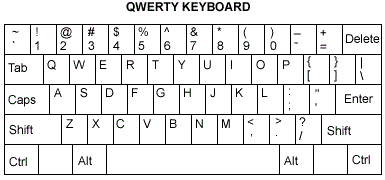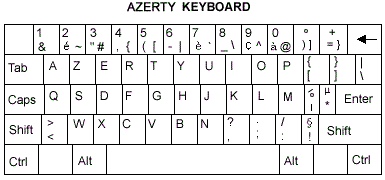Terms Used in Typing
WPM
Alternatively referred to as WAM, which is short for Words a Minute, WPM is short for Words Per Minute and is the measurement of how many words a minute someone is capable of typing without making any errors. For example, someone who is capable of typing 68 WPM is going to be able to type more than someone who only types 32 WPM.
Many companies who employ people who work on computers now require new employees to take a typing test for part of the hiring process. If you do not meet the company's requirements, you will not be considered for the job.
CPS
Characters per second. This is another measurement of one's typing speed. Refers to the number of characters one can type per second. Though CPS exists, WPM is more standardised and common way of expressing typing speed.
QWERTY
Alternatively referred to as the Sholes keyboard, the QWERTY keyboard was invented by Christopher Sholes who invented the typewriter in 1868. The QWERTY keyboard is named after the five letter keys located at the top left side of the keyboard and is now the official standard of computer keyboards (ISO 9995). Today, the QWERTY keyboard is the most commonly found and used computer keyboard in the United States. Below is an image of the keyboard keys layout on the QWERTY keyboard.

Touch Typing
Touch Typing (also called touch type or touch method) is typing without using the functionality of eyes. In simple words, typing without looking at the keyboard. A typist will remember keyboard key locations through brain memory (or through muscle memory).
AZERTY
French speaking typewriter and computer keyboard layout named after the top left six characters, a, z, e, r, t, and y. Below is a basic example of the layout of the azerty keyboard.

ACCURACY
Though typing speed is significant, accuracy is as important as well. Accuracy is normally expressed in percentage. It is a measure of typing errors one make. An accuracy of 90% means 10 errors made while typing 100 words. Higher accuracy with good typing speed accounts for greater productivity. An average accuracy of 95% or more is a must to consider one's typing speed. If you have high typing speed with very little accuracy, it accounts for very less productivity.
Ergonomic Rules
It is a set of directives so that you dont get stress or strain after typing for long hours. These directives are intended for professional typists or stenographers who has to type for longer hours in their daily life. These are basic rules or general thumbs on how you should sit, rest your palm and so on while typing.
Keystroke
A keystroke is a single press of a key on a keyboard. Each key press is a keystroke. Keystrokes can be used for programming purposes to respond to the user pressing a particular key. However, they can also be used for things such as keystroke logging, where a user's keystrokes are tracked either with or without the prior knowledge or consent of the user.
Numeric Keypad
Also referred to as the number pad, the numeric keypad is a 17-key keypad usually found on the far right side of a typical IBM 101 / 2-key keyboard. The U.S. numeric keypad contains the below keys (going from top left to bottom right).
101 Keyboard
Alternatively referred to as the 101-key keyboard, the AT keyboard is a US standard keyboard introduced in 1986 by IBM. Unlike new keyboards the ATkeyboard does not include the additional three Microsoft Windows keys now found on many IBM compatible keyboards.
An AT keyboard may also be used to describe a keyboard that uses the AT (Din5) port as shown in the picture to the right. The Din5 Port is rarely used today since most computers use PS/2 and USB keyboards.
104 Keyboard
Alternatively referred to as the Windows keyboard, the 104-key keyboard is a keyboard found with most new computers today that incorporates three additional Microsoft Windows keys.
